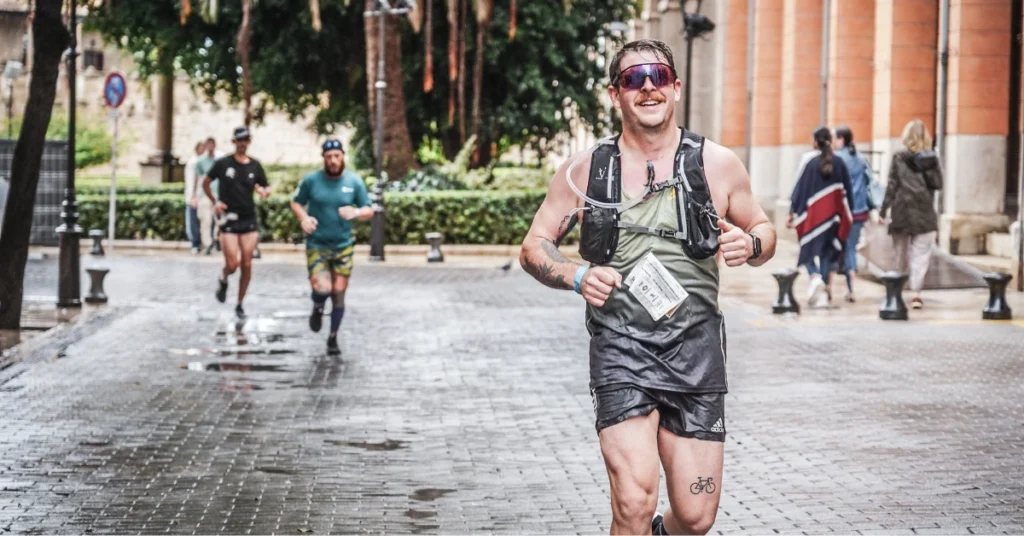Dive into the benefits of -water jogging-, a low-impact exercise that replicates the motion of running without stressing your joints. Whether you’re recovering from an injury or aiming to diversify your workout routine, water jogging offers a comprehensive and adaptable workout suitable for all fitness levels. Get ready to enjoy the cardiovascular benefits and calorie burn in a refreshing way!
Pro´s:
- ✅ 100% Foam
- ✅ Comfortable fit
- ✅ Made in the USA
Con:
- ❌ Only one color
Fundamentals of Water Jogging
Let’s explore the core aspects of water jogging and understand why it is a valuable exercise for many.
🏊 What Is Water Jogging?
Water jogging is a type of aerobic exercise that is performed in the water, simulating the action of land jogging. Essentially, we jog in a pool, without our feet touching the bottom, often with the aid of a flotation device like an Aquajogger. This exercise can be done in both shallow and deep water, but deep water running more closely mimics actual jogging because there is no impact with the pool floor.

“Personally, I think water jogging is a great cross-training option. If I have to decide, I will always prefer the land unit, but as I said, it is the best for cross-training.”
🎯 Benefits of Water Jogging
The key advantages of water jogging include:
- ✅ Low-Impact Exercise: It reduces stress on joints, making it ideal for injury rehabilitation.
- ✅ Cardiovascular Fitness: It increases our heart rate and improves overall stamina.
- ✅ Muscle Strengthening: The water’s resistance ensures that we engage more muscles than we would while jogging on land.
- ✅ Calorie Burn: A significant number of calories are burned due to the effort required to move against the water’s resistance.
- ✅ Improves Flexibility: As we move through the water, our range of motion improves, which helps to increase flexibility.
By incorporating water jogging into our fitness routine, we access a workout that’s as effective as it is therapeutic. With its range of benefits, it’s no wonder that this form of exercise is a staple for many fitness enthusiasts and athletes alike.
Getting Started

To embark on aqua jogging, we require specific equipment and a fundamental understanding of the activity. This low-impact exercise not only offers us a break from routine workouts but also engages our body in a refreshing and resistance-based fitness challenge.
🏊 Equipment Needed
Before we dive into the pool, it’s essential that we equip ourselves with the appropriate gear.
Essential Aqua Jogging Gear:
- ✅ Flotation Device: A flotation belt is crucial as it provides the necessary buoyancy to maintain an upright position.
- ✅ Proper Swimwear: Comfortable and snug-fit swimwear to ensure ease of movement.
- ✅ Water Shoes (Optional): For added grip on the pool floor, though not mandatory.
📘 Understanding the Basics
Understanding the basics is just as important as having the right equipment. At the core of aqua jogging is the replication of our land-based jogging motion in the resistance of water.
Key Concepts:
- ✅ Buoyancy: With the aid of the flotation device, we attain a neutral buoyancy so our feet do not touch the pool floor, simulating the jogging experience.
- ✅ Posture: We keep our body upright, with a slight forward lean, activating core muscles similar to regular jogging.
- ✅ Leg Movement: Mimic the running motion; our legs will make cyclical, running movements under water.
Technique and Form

When it comes to water jogging, our technique and form are crucial for an effective workout. We focus on maintaining a good posture and proper movement to engage the right muscles and ensure we’re getting the most out of our time in the water.
🏊 Proper Water Jogging Form
Our goal with water jogging form is to mirror our on-land running form as closely as possible. This involves a neutral spine and a slight forward lean from the ankles, not the waist. We make sure our arms move in a controlled, but relaxed, manner with elbows bent at approximately 90 degrees. Our hands should be unclenched, avoiding unnecessary tension.
Moving to our lower body, we emphasize the importance of the full range of motion. Our legs should simulate the running gait with the knees lifted, and our hip flexors engaged as if we are running on land. To avoid drag and maintain buoyancy, our feet shouldn’t touch the bottom of the pool.
🌬 Breathing and Posture
Our posture remains upright, with our head looking straight ahead, and our spine aligned. It’s vital to avoid hunching our shoulders, as this can lead to poor form and potential strain.
Breathing rhythmically and deeply is important just as it is with running on land. In water jogging, we inhale deeply through the nose and exhale through the mouth, ensuring a steady flow of oxygen to our working muscles.
Workout Structure
When we discuss the workout structure for water jogging, it’s important to focus on the sequence and the variety within our routines. We need to ensure that our body receives the full benefit of the workout, which can be achieved through proper warm-up, intervals, and a cool down phase.
🏃♂️ Warm-Up and Cool Down
Properly structured water jogging sessions start with a warm-up. This can last about 5-10 minutes, gradually increasing heart rate and blood flow to the muscles. An effective warm-up could include slower water jogging or specific movements that mimic the main workout but at a lower intensity.
A cool down is just as important as the warm-up and should take place for an equal amount of time at the end of our session. This usually involves water walking or gentle jogging to bring down our heart rate to a resting state and help in the recovery process, ensuring that we reduce the likelihood of muscle soreness.
🔄 Developing a Workout Routine
When we create our workout routine, it’s essential to include intervals where we alternate between high-intensity bursts and lower-intensity recovery periods.
For instance:
- 3 minutes of moderate-paced water jogging
- 1 minute of high-intensity water jogging
- 1 minute of light water jogging or walking for recovery
Repeat this sequence for the desired number of repetitions or for a set time period, aiming for a total workout time of 20-45 minutes, depending on our fitness level and goals.
Advanced Water Jogging

Advanced water jogging takes our deep water running experience to new heights. We’re focusing on refining our deep water techniques and integrating interval training to boost speed and enhance recovery.
🏊 Deep Water Techniques
In advanced water jogging, we employ techniques that maximize resistance for increased muscular strength and cardiovascular endurance. Utilizing a buoyancy belt, we maintain an upright position and mimic land-based running motions.
It’s crucial to perfect our form, which includes:
- ✅ Proper Posture: We keep our body vertical, with a slight forward lean.
- ✅ Arm Movement: Our arms move as they would on land, with elbows bent at roughly 90 degrees.
- ✅ Leg Action: We simulate running by ensuring a full range of motion in our leg stride.
🏃 Interval Training and Recovery
Interval training in deep water improves both our aerobic and anaerobic capacities.
Here’s how we implement it:
- ✅ Work Phases: We alternate between high-intensity sprints and moderate-paced running, typically ranging from 30 seconds to several minutes.
- ✅ Recovery Phases: Following each burst of speed, we shift to a slower pace or stationary floating to allow for recovery, which can last as long as the work phase.
Health and Rehabilitation
In this section, we’ll explore how water jogging serves as an effective means for both preventing injuries and aiding in rehabilitation.
🏊 Injury Prevention
Water jogging is a low-impact activity that significantly reduces the strain on our joints compared to traditional running. By taking advantage of the buoyancy of water, we lower the risk of impact-related injuries that are common with high-impact exercises.
- Key Benefits:
- Reduces weight-bearing stress by up to 90%
- Allows for a full range of motion without the harsh impact of land-based workouts
Studies show that water jogging can mitigate the risk of injuries by lessening the impact on our weight-bearing joints.
🩹 Rehabilitation and Therapy
Following an injury, water jogging has proven to be an invaluable method in our rehabilitation toolkit. It’s a therapeutic activity that we can use to maintain cardiovascular fitness without exacerbating injuries.
- Components:
- Natural Resistance: Water provides resistance to help strengthen muscles.
- Free Range of Motion: The water environment allows for movement without the pain of joint stress.
We utilize the controlled setting of a pool to collaborate closely with physical therapists for tailored rehabilitation programs. Individuals who are injured can benefit from aquatic exercises to improve endurance and muscle strength, which supports faster and safer recovery periods.
Water workouts like aqua jogging also play a crucial role in therapy programs, especially for conditions like arthritis, where the reduction in weight-bearing can alleviate pain. By performing exercises in the water, our patients can work on regaining strength and flexibility with less discomfort during their rehab process.
Biomechanics and Performance

When we examine water jogging, we must consider two vital components: the enhancement of running performance through specialized training and the unique biomechanics involved. Understanding these aspects can help us improve strength and endurance, benefiting muscle function and joint health due to the low-impact nature of the exercise.
🏃 Enhancing Running Performance
Studies indicate that water-based training, when effectively employed, can maintain or even boost aerobic fitness. Specifically, incorporating deep water running (DWR) into our routine can be a strategic complement to our training, as it aids in maintaining cardiovascular endurance without the risk of overuse injuries.
🌊 Biomechanics of Water Jogging
The biomechanics of water jogging differ substantially from traditional running. The resistance of water provides a consistent challenge for our muscles, promoting increased muscle activation compared to running on land.
It’s crucial for us to concentrate on proper form, emphasizing a full range of motion to engage the correct muscle groups while preventing stress on our joints. The buoyant forces in water reduce our body weight’s impact, allowing for a focus on technique that can translate to better performance on land.
The hydrodynamic properties of water also encourage a more upright posture, challenging our core and stabilizer muscles, which can lead to improved balance and joint stability.
Nutrition and Hydration
Nutrition and hydration are crucial to maximizing the benefits of water jogging. We need to fuel our bodies adequately and ensure we’re hydrated to support the increases in metabolic rate and energy expenditure that come with this exercise.
🍽️ Dietary Considerations
Proper nutrition before water jogging helps ensure we have the energy needed to sustain our workout and supports optimal blood flow and muscle function.
Here’s how we can craft our diet to support our exercise regimen:
- ✅ Carbohydrates: Our body’s primary energy source, especially for aerobic activities like water jogging.
- ✅ Protein: Vital for muscle repair and recovery, especially after we exercise.
- ✅ Fats: Should be consumed in moderation; they’re a backup energy source.
- ✅ Vitamins and Minerals: Essential for various bodily functions, including energy production and oxygen transportation in the blood.
It’s important to eat a balanced meal a few hours before exercising to give our body time to digest and convert food into energy.
💧 Staying Hydrated During Exercise
Hydration is essential to account for the water we lose through sweating, even while in water.
Here’s our guide to stay properly hydrated:
- ✅ Before Exercise: Drink at least 16 ounces of water 2 hours before water jogging to ensure starting off well-hydrated.
- ✅ During Exercise: Regularly sip water during exercise to replace lost fluids, aiming for 6 to 8 ounces every 15-20 minutes.
- ✅ After Exercise: Rehydrate with water or an electrolyte drink to replenish any fluids lost through sweat.
It’s also worth noting that we should adjust our fluid intake based on the intensity of the exercise and our individual sweat rates, which can increase our energy expenditure.
Cross-Training and Fitness

In our pursuit of fitness, we recognize the value of cross-training as a method to complement our regular land workouts. We aim for a well-balanced exercise regimen that incorporates both water and land exercises to enhance strength, core stability, and overall fitness.
🏊 Integration with Land Workouts
When integrating water jogging into our land-based training routine, we focus on the running motion to retain muscle memory and cardiovascular benefits. By doing this, we ensure that the cardiovascular strength and endurance we build in the water transfer effectively to our land runs.
For example:
- Monday: Land run
- Wednesday: Aqua jogging
- Friday: Land run
- Sunday: Aqua jogging
This schedule allows each modality to complement the other, maintaining running fitness while simultaneously reducing injury risk.
🏃♂️ Balancing Water and Land Exercises
To balance water and land exercises, it’s essential to consider the impact each has on our bodies. Water exercises, like aqua jogging, provide low-impact training which is crucial for injury prevention and recovery. Our approach aims to build endurance and strength while minimizing the risk of overuse injuries.
By maintaining an even balance, we can address different aspects of fitness—using land workouts to improve speed and agility, and water exercises to enhance strength and improve recovery. We advocate for a complementary relationship where each form of exercise provides what the other lacks, leading to a comprehensive fitness strategy.
Special Considerations
In water jogging, we must cater to the diverse needs of individuals with varying abilities and health considerations. By properly adjusting the exercise to fit specific populations and physical limitations, we can ensure a safe and effective workout.
🏊♂️ Training for Specific Populations
Runners: For both recreational and elite athletes, including those preparing for a marathon, water jogging can be integrated into training regimes to enhance cardiovascular fitness without the high impact on joints often associated with road running.
- Injured Runners: Use water jogging as a rehabilitation exercise to maintain fitness levels. The water’s buoyancy supports the body and reduces stress on healing structures.
- Individuals with Osteoporosis or Arthritis: Water jogging is a low-impact activity that can help in maintaining bone and joint health, alleviating the pain, and improving joint function.
🛠 Adapting to Physical Limitations
Fibromyalgia Sufferers: For those with fibromyalgia, starting slowly and increasing the duration gradually is key. The warmth and resistive properties of the water can help in reducing muscle stiffness and improving movement range.
- Arthritis Patients: Regular sessions can potentially enhance flexibility and joint movement while also lessening discomfort.
- Older Adults: When adapting workouts for older adults or those with physical limitations, safety is paramount. Ensuring proper support and using flotation devices can facilitate an effective, low-risk workout.
Equipment and Accessories

When we take up water jogging, selecting the appropriate equipment and ensuring its upkeep are crucial for a safe and effective workout. The right gear enhances buoyancy, movement, and visibility in the water, while regular maintenance guarantees longevity and performance.
🏊♂️ Choosing the Right Gear
The foundation of water jogging is the aqua jogging belt. This is a flotation device designed to provide enough buoyancy to keep you afloat while allowing free movement of arms and legs.
We recommend looking for a belt that is adjustable and fits snugly around your waist for maximum support.
As for visibility and eye protection, investing in a good pair of goggles is key. A clear line of sight under water is essential, and goggles help prevent irritation from chlorine or saltwater.
🛠 Maintenance and Care
- ✅ Rinse aqua jogging belts and flotation devices with fresh water after each use to remove chlorine or salt.
- ✅ Thoroughly dry all equipment, especially those with metal components, to prevent degradation.
- ✅ Store running belt and accessories in a cool, dry place to prevent mildew or warping of materials.
- ✅ Regularly inspect gear for wear and tear, including checking the integrity of buckles and straps to catch issues before they impact your workout.
Troubleshooting and Tips
In water jogging, success hinges on overcoming common challenges and honing our technique to maximize the workout’s effectiveness. Let’s address these aspects methodically.
📌 Common Challenges
Coordination: Many of us may find the coordination needed for proper form in aqua jogging challenging at first. It’s crucial to focus on mimicking land running form to benefit fully from this exercise. To maintain proper posture, keep your body upright and avoid leaning forward or backward.
Resistance: Water provides natural resistance, which is great for strength training but can cause difficulties in maintaining speed. Use the resistance to your advantage by ensuring that each movement is deliberate and controlled.
📌 Maximizing Effectiveness
Form Matters: Our form is integral to the effectiveness of our water jogging sessions. Aim to have a high knee liftand a consistent arm swing. Our movements should be fluid and replicate those of running on land to the best of our ability.
Resistance Training: To elevate our workout, consider incorporating resistance equipment like aqua jogging belts or cuffs. This equipment enhances our strength and can increase the intensity of our workouts. Remember to adjust the resistance levels to fit our personal capabilities and goals, ensuring progressive improvement in our fitness levels.
Our Option on Water Jogging
Water jogging is an exercise we’ve found to strike a unique balance between intensity and gentleness on the body. Essentially, it harnesses the resistance of water while mimicking the movements of terrestrial jogging, which allows us to get a solid cardiovascular workout without the high impact on our joints.

Equipment We Use:
- Buoyancy belt
- Waterproof fitness tracker
Why We Advocate for Water Jogging:
- Low Impact: Our joints are spared the harsh impact encountered on pavement, making it ideal for injury recovery or joint conditions.
- Cardiovascular Fitness: Despite being a low-impact exercise, it elevates our heart rate effectively.
- Strength Training: The natural resistance of water provides a moderate strength workout for our muscles.

Exercises Included in Our Routine:
- Standard water jogging
- High-knee lifts
- Sprint intervals
How We Approach Water Jogging: To maximize the benefits, we utilize a buoyancy device around the midsection to maintain an upright position. Our movements are deliberate, emulating land-based jogging, ensuring that our upper body is upright and the core is engaged.
FAQ
Is water jogging a good workout?
Yes, water jogging provides a low-impact, full-body workout that can improve cardiovascular fitness and strength.
How deep should the water be for water jogging?
The water should be waist to chest deep for effective water jogging.
What are the benefits of water jogging?
Water jogging can help improve endurance, strength, flexibility, and can aid in rehabilitation from injuries.
What is your option on Water Jogging? I would love to hear it in the comments. I’m sure you also like reading about Post Run Feeling or Puns About Running.



